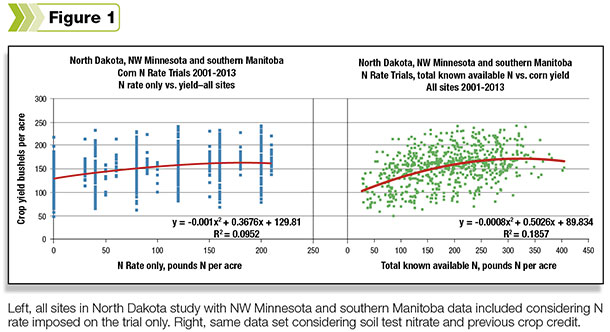When I left the university with my master’s degree in 1976 and joined a fertilizer retail chain as agronomist, corn yields averaged about 140 bushels per acre. At the same time in North Dakota, where I have been North Dakota State University extension soil specialist for almost 20 years, yields were about 80 bushels. When I visit old corn grower friends in Illinois, they tell me that their average is over 200 bushels per acre, and corn growers in eastern North Dakota often average over 160 bushels per acre.
Most corn nutrient recommendations are at least 40 years old. Illinois joined Minnesota, Iowa, Wisconsin and several other states several years ago and changed their N recommendation from a yield-based formula (most often N recommended = 1.2 x yield goal less credits to previous crop) to one that is both N yield response-based and economics-based.
This concept was championed by John Sawyer at Iowa State and Emerson Nafziger at Illinois in a paper in 2005. The idea of linking a nutrient recommendation to economics is not new: Ardell Halvorson, USDA-retired, used an “economic production function” to suggest P (phosphorus) recommendation in wheat about 30 years ago, but the idea did not get traction from the general research and extension community.
With volatile corn prices and N prices, the idea of linking modern research-based yield responses with economics is very appealing.
It might surprise some that N recommendations with these new tools are not much higher than those made for top yields 30 years ago. I think the reason for the stability of N rates over time is the way corn is bred and hybrids are selected. Breeders continue to select for higher yields, and although most make sure nutrients are not limiting, there is a tendency to use similar rates each season.
Over time, higher-yielding cultivars are selected that use these nutrients most efficiently. I know of no breeding program that imposes hybrid selection over a stair-stepped N rate plot structure. The result is that our current hybrids require less N per bushel than hybrids used in the past.
North Dakota is in the process of revising our N recommendation for North Dakota corn growers (available early summer 2014).
Not only will our new recommendation system use the “Return to N” economic production function used by our Eastern neighbors, but it also divides the state into different recommendations for use in different agri-climates (east versus west), soils (high-clay versus medium textures), tillage practices (conventional versus long-term no-till) and productivity history (higher than 160 bushels per acre versus lower).
North Dakota also has used soil test nitrate to 2 feet in depth as an adjustment to N rate.

The left side of Figure 1 , shows our data set without regard to soil test or previous crop credit. The possible yields with no additional N are almost as extreme as any N rate imposed on the trials. With soil test nitrate considered ( Figure 1 , right side), the relationship between N and yield improves and the range of possible yields at lower N levels is more reasonable.
In the course of data collection for the corn N rate trial from 2010-2013, soils with a high clay component and soils with sandier textures required far more N to achieve maximum yield compared to medium-textured soils with higher productivity. To maximize yields and to achieve greater N efficiency required attention not to rate, but to timing.
Corn lingers in the soil or at early growth stages up until six-leaf stage (V6), using less than 10 percent of its total growing season N requirements. During the next two weeks, corn requires almost 50 percent of its N requirements, with the remainder taken up during grain fill.
If the season is wet in May and early June, high N losses are possible in sandier soils due to leaching and in high-clay soils due to denitrification, which is a bacteria-controlled process in low oxygen conditions where nitrate is transformed to nitrous oxide gases and N2 gas. Therefore, if growers in these sensitive soils use a side-dress strategy to split their N application, the sensitive early season loss of N can be avoided.
Rates to use at side-dress time are currently a guess. However, using technology developed by Dr. Bill Raun at Oklahoma State, now marketed by Trimble as the GreenSeeker, and similar technology developed by Holland Scientific and others, sensors can be used to help predict N requirements at side-dress for corn.
Our research at North Dakota State University was conducted using the GreenSeeker Red and Red-Edge bands with near-infrared bands, and the Holland Scientific Crop Circle using Red and Red-Edge bands at V6 and V12.
The red and near-infrared bands are used to calculate a normalized differential vegetative index (NDVI) that estimates two-dimensional biomass. The red-edge and near-infrared-bands are used to calculate a red-edge NDVI that relates more to the “greenness” of the foliage than biomass.
The red NDVI from both instruments were both successful in predicting yield at V6. The red-edge NDVI was most useful at V12. Multiplying the red NDVI times corn height improved the relationship of readings and yield at V12, but finding a sensor to measure crop height adequately may be challenging.
The way the GreenSeeker can be used to predict an N rate is as follows.
• A formula developed to relate the GreenSeeker reading divided by growing-degree days from harvest is used within the N-rate control software.
• When the grower applies the foundation N rate to the field, a short boom-width high-N rate (perhaps 200 pounds of N per acre) is applied within a representative soil.
• When the grower enters the field at side-dress time, the first area sensed is the high N reference area. This establishes the yield that could be achieved with highest N rate.
• Any reading within about 5 percent of the reference reading receives no additional N.
• Readings lower than the 5 percent threshold predicts a yield less than that of the reference area.
• Multiplying the yield difference x 56 pounds grain per bushel x 1.25 percent N in the grain gives the N that must be taken up by the corn to achieve the higher yield.
Since no N applied is 100 percent efficient, an efficiency factor must be imposed to estimate the rate of N required. Usually an in-season N application is considered about 60 percent efficient.
The rate controller makes these calculations at the speed of light, enabling the rate controller to change N rate on the go in response to sensor-reading differences.
Modern corn N recommendations are conducted using N response formulas that are field research-derived using modern varieties, and some, as the upcoming North Dakota State University recommendations will be, have region, soil, tillage and soil productivity differences included that will aid in site-specific application.
Certain soils impose N loss challenges on growers. Sensors such as used in our research have great potential to improve grower N use efficiency and increase yields on those problem soils. PD
Dave Franzen is an extension soil specialist with North Dakota State University. He can be reached by email .

Dave Franzen
Extension Soil Specialist
North Dakota State University






